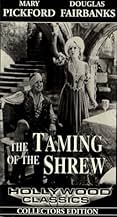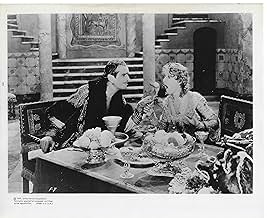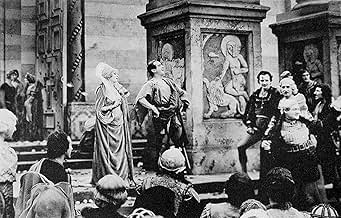Añade un argumento en tu idiomaIn sixteenth century Padua, Hortensio loves Bianca, the youngest daughter of Baptista. But Baptista will not allow the two to get married until his eldest daughter, the extremely headstrong ... Leer todoIn sixteenth century Padua, Hortensio loves Bianca, the youngest daughter of Baptista. But Baptista will not allow the two to get married until his eldest daughter, the extremely headstrong Katherine, is betrothed. This task seems impossible because of Katherine's shrewish demean... Leer todoIn sixteenth century Padua, Hortensio loves Bianca, the youngest daughter of Baptista. But Baptista will not allow the two to get married until his eldest daughter, the extremely headstrong Katherine, is betrothed. This task seems impossible because of Katherine's shrewish demeanor. They believe their prayers have been answered with the arrival from Verona of the lust... Leer todo
- Dirección
- Guión
- Reparto principal
- Premios
- 2 premios en total
- Servant
- (sin acreditar)
- Little Boy
- (sin acreditar)
- Little Girl
- (sin acreditar)
- Servant
- (sin acreditar)
Reseñas destacadas
Hollywood royalty Douglas Fairbanks and Mary Pickford star as Kate and Petruchio, the warring couple who really love each other on the sly. Their marriage was a sham by the time this flick came out, and both their careers were on the wane, but they give reasonable enough performances, even though Fairbanks looks a few years too old for his part when the camera gets close. There's still a tendency to exaggerate their gestures and overact to responses to words being spoken, but they're no worse than any other stars making their first sound films.
It's clear that Hollywood back then had no more confidence in the intelligence of its audience than it does today: this is Shakespeare for the common man, with the pith of the Bard's prose removed in order to make the words readily understandable to all. Although the film is little more than an hour long, it does begin to drag during the last twenty minutes but, that aside, it's not a bad effort.
Variety was upbeat on "The Taming of the Shrew," commenting "While there is plenty of romance and dialog, slapstick and mud, there's no dirt, so that part of Pickford's career remains as clean as ever. Splendid settings in the Fairbanks massive production manner." Modern assessments of the film are less than praiseworthy, especially knowing in hindsight that both careers took a deep dive after the "Shrew." Says Leonard Maltin, the movie "was defeated by its lack of pacing and downright embarrassing performances, though it's undeniably fascinating to see Doug and Mary together in their only co-starring appearance." Years later, Pickford said it was her worst performance of her life. She did admit, however, that Fairbanks excelled as his portrayal of Petruchio.
"The Taming of the Shrew" was the first Shakespearian play brought to the screen as a talkie. The feature film was based more on the Richard Garrick's version of the farce, his 'Katherine and Petruchio.' The 1929 film incorporates about 20 percent of Shakespeare's written dialogue, and the movie's English, still Elizabethan, is updated somewhat to make it more understandable for the modern audiences.
Today's viewers to "The Taming of the Shrew" will take notice that Fairbanks' harsh treatment of Katherine is so over-the-top many felt back then the actor was taking out all his frustrations of the couple's personal relationship out on her. And Pickford's punchy attitude was equally demonstrative by her excessive yelling and physicality towards him, portions that were not written in the script. Pickford claims all the fault laid at the director, Sam Taylor's feet, a surprising allegation since both he and the actress got along swimmingly during their last collaboration, 1927's "My Best Girl."
As one reviewer noted, "The acting that had made Pickford and Fairbanks the 'King and Queen of Hollywood' rendered their performing style obsolete overnight. It's important to remember, of course, that the change brought about by sound had absolutely nothing to do with their deficiencies as performers, but only emphasizes the differences between silent and sound film. Watching a film like 'The Taming of the Shrew,' and comparing it to what they were both doing just months earlier, makes a strong case that the silent and sound film are really two entirely different things."
Petruchio really is quite a suitable role for Fairbanks, and his buoyant confidence works well. His portrayal seems to be pretty close to the kind of character that Shakespeare intended. The role of Katherine doesn't give Pickford a chance to use her greatest strengths. She does project good energy, and has plenty of charm when it is called for, but at times her portrayal doesn't seem to fit the original conception of the character, and the role definitely did not give Mary the chance to display her wide range of talents with more subtle material.
The story is a rather loose, jaunty adaptation of the original, and there would be little point in making detailed comparisons. As a movie, most of it works all right aside from the occasional instances of awkwardly-paced dialogue and the like that are characteristic of so many films of the early sound era. Fairbanks does help make some of these moments less noticeable with his obvious good humor. There are certainly a number of obvious ways in which it could have been better, and it's fair to point them out. Yet it still has enough of the classic story, plus enough of its own energy, to make it worth seeing as long as you know what to expect.
Of the two stars, Doug is clearly the better. Director Sam Taylor moulds the roles around the performer, and not the other way around, which was unwise but understandable. The Fairbanks image suits Petruchio better than Pickford's suits Kate. (At her best Pickford is magnificent, at her worst embarrassing. She herself called it one of her worst performances, and there is no reason to doubt her.)
For an early talkie it has remarkable fluidity, though it is only the 1966 re-edited version that is available today. (When I approached the Mary Pickford Company in 1992 to see if I could arrange a screening of the 1929 release print - which was longer and had a different score - I was politely but firmly told to go away!)
Two points of interest. This film was emphatically not the box office flop that many writers have claimed; it returned a healthy profit on its first release. And the credit line "by William Shakespeare, with additional dialogue by Sam Taylor" is pure myth. It appears not in the script, the 1966 nor in the 1929 (I have it on reliable authority) prints of the film. Where do these things get started?
¿Sabías que...?
- CuriosidadesIn her later years, Mary Pickford stated that working on the film was the worst experience of her life, although she also acknowledged that Douglas Fairbanks's performance was one of his best.
- Versiones alternativasAfter many years out of circulation, the film was re-released in 1966 in a new cut supervised by Mary Pickford herself. New sound effects were added throughout, much of the voice dubbing was enhanced with newly available technology, and seven minutes were cut from the initial print. This re-released version is the only version now available on DVD or VHS.
- ConexionesFeatured in Mary Pickford: A Life on Film (1997)
Selecciones populares
Detalles
Taquilla
- Presupuesto
- 504.000 US$ (estimación)
- Duración
- 1h 3min(63 min)
- Color





























